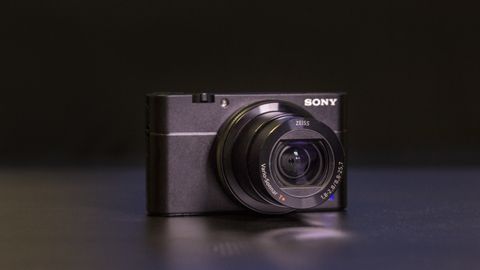Why you can trust TechRadar
Build and handling
- Solid metal construction
- Design remains virtually identical to RX100 IV
- Weighs 299g
Sit the RX100 V next to its predecessor – or the RX100 III for that matter – and with the exception of the model number you’d be hard pressed to tell them apart. The pocket-sized metal body is pretty much exactly the same, and follows the same minimalist design we first saw on the original RX100.
It’s certainly a sleek, understated-looking compact, with the high-end, premium feel you’d expect from a camera of this calibre.
However, sticking with the same design ethos also means Sony continues to determinedly avoid putting any form of handgrip on the front, which is a shame, because the smooth finish doesn’t deliver the secure grip we’d like, especially when you compare it to the Canon G7 X Mark II, which has a raised and textured grip to provide a much more satisfying hold.
There are aftermarket solutions – including some from Sony itself, like the AG-R2 – but it would have been nice to have seen some effort to come up with a built-in solution on what is, after all, the fifth-generation model.



The RX100 V kicks into life either via a press of the On/Off button or when you release the pop-up viewfinder – there’s a sprung switch on the side of the camera that releases the EVF, and the front section then extends away from the casing before being locked into place.
It would be nice to see a little more resistance here, as we found that on occasion, especially if you’re wearing glasses, it's a little too easy to inadvertently push the viewfinder back into the housing when the camera is raised to your eye.
There’s a customisable control ring around the barrel of the lens to which you can assign a range of functions, but it does have its quirks. If you're shooting in aperture priority mode it’s intuitive to set the ring to adjust the aperture, but the rear control ring also defaults to this function, with exposure compensation accessed only once you’ve tapped downwards to activate it – it would be nice to see exposure compensation enabled here by default.
Swap to shutter priority mode and the control ring is disabled, requiring you to dive back into the overly complicated menu system to re-assign the functionality of it. You can still use the rear control ring to set the shutter speed, but it's frustrating that the front control ring can’t just swap automatically between aperture and shutter control when you switch between these two popular shooting modes.
Don’t get us wrong: there’s a wealth of customisation available with the RX100 V, but it can be unnecessarily fiddly getting to some settings
To make life simpler, the most straightforward setup we found was to set the front control ring to exposure compensation, and use the rear control ring to adjust either aperture or shutter speed, depending on which mode was selected.
Don’t get us wrong: there’s a wealth of customisation available with the RX100 V, but it can be unnecessarily fiddly getting to some settings, and perhaps it’s time Sony took another look at the control layout, which has remained pretty much unchanged since the original RX100, given that several new features have been added since the first model came out.
Autofocus
- 315-point phase-detection AF
- 5 focus area modes
- Advanced focus tracking
Perhaps the biggest change from the RX100 IV is the arrival of a 315-point phase-detection AF system – something we’ve never seen before in a 1.0-inch sensor compact camera. Coverage is pretty impressive too, with most of the frame covered, with the exception of the extreme left and right edges.
That said, if you’re in Single AF mode you’re unlikely to appreciate the level of sophistication on offer from the AF, with the RX100 V relying on a hybrid AF system – phase-detect AF is used to initially snap the subject into focus, with contrast-detect taking over to fine-tune focus, so there’s a very brief delay (and we’re splitting hairs here) as the system monetarily hunts to acquire focus.
Select the Wide area AF option in Single AF mode, though, and you’ve got a fast and hassle-free way of getting your shots in focus, with the camera automatically deciding what part of the frame it wants to give prominence to.
If you need to give the RX100 V some direction you’ve got Center, Flexible Spot and Expand Flexible Spot (with the addition of eight points around the desired AF point to assist with AF) modes – with the latter two of these enabling you to manually move the AF point round the frame.

This is where a touchscreen interface would come in handy, as to shift the AF point round the frame you first have to hit the button in the center of the rear control ring, before toggling it round the frame to arrive at your desired point – and not forgetting to hit the central button again to exit AF point selection, otherwise you’re locked out of the RX100 V’s other shooting controls. It would be much easier and quicker to simply tap where you wanted to focus.
On top of that there’s Face Detection, which can be switched on and off within the menu.
Continuous AF is where things get interesting though, if a little complex given the multitude of settings at your disposal, especially as there’s the extra Lock-on AF focus mode added to the mix, with the choice of Lock-on Center, Flexible Spot and Expand Flexible Spot. There’s almost too much choice here.
Once the camera has locked onto your subject – once you’ve specified your subject that is, which isn’t always as straightforward as it may seem, with brightly colored subjects seeming to take precedence over the subject we pointed our AF point at – the speed at which it tracks your subject is impressive, and all this at 24fps.
Current page: Build, handling and AF
Prev Page Introduction and key features Next Page Performance and image qualityPhil Hall is an experienced writer and editor having worked on some of the largest photography magazines in the UK, and now edit the photography channel of TechRadar, the UK's biggest tech website and one of the largest in the world. He has also worked on numerous commercial projects, including working with manufacturers like Nikon and Fujifilm on bespoke printed and online camera guides, as well as writing technique blogs and copy for the John Lewis Technology guide.

